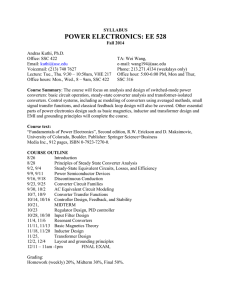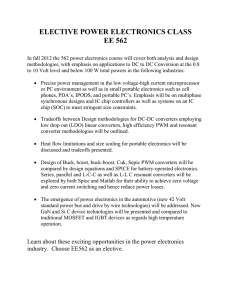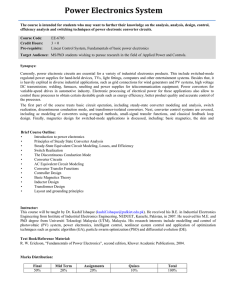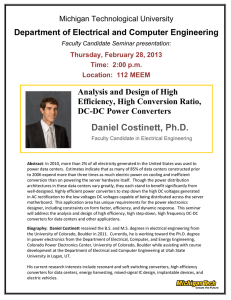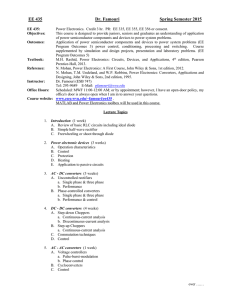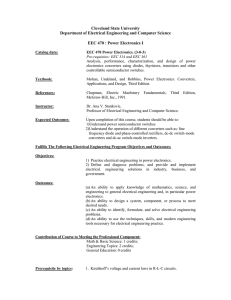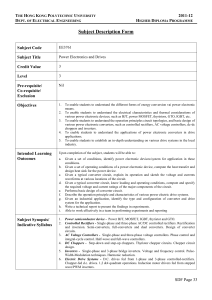EE4007A - The Hong Kong Polytechnic University
advertisement
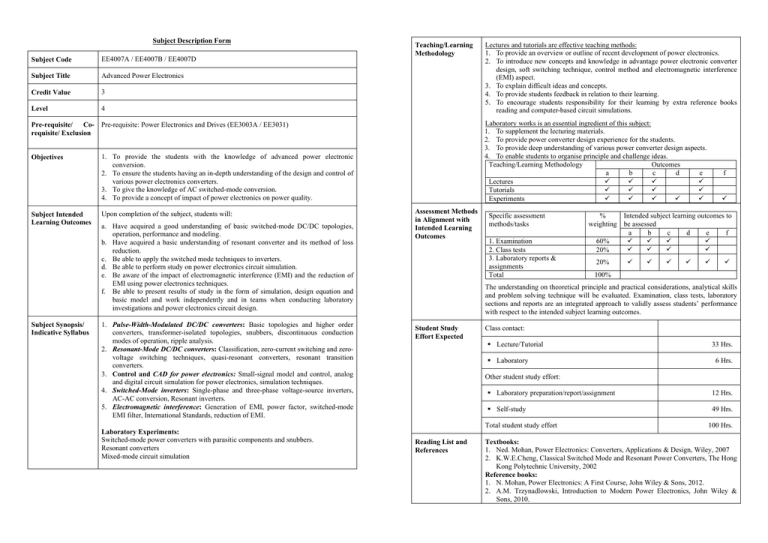
Subject Description Form Subject Code EE4007A / EE4007B / EE4007D Subject Title Advanced Power Electronics Credit Value 3 Level 4 Teaching/Learning Methodology Laboratory works is an essential ingredient of this subject: 1. To supplement the lecturing materials. 2. To provide power converter design experience for the students. 3. To provide deep understanding of various power converter design aspects. 4. To enable students to organise principle and challenge ideas. Teaching/Learning Methodology Outcomes a b c d e Lectures Tutorials Experiments Pre-requisite/ Co- Pre-requisite: Power Electronics and Drives (EE3003A / EE3031) requisite/ Exclusion Objectives Subject Intended Learning Outcomes Subject Synopsis/ Indicative Syllabus 1. To provide the students with the knowledge of advanced power electronic conversion. 2. To ensure the students having an in-depth understanding of the design and control of various power electronics converters. 3. To give the knowledge of AC switched-mode conversion. 4. To provide a concept of impact of power electronics on power quality. Upon completion of the subject, students will: a. Have acquired a good understanding of basic switched-mode DC/DC topologies, operation, performance and modeling. b. Have acquired a basic understanding of resonant converter and its method of loss reduction. c. Be able to apply the switched mode techniques to inverters. d. Be able to perform study on power electronics circuit simulation. e. Be aware of the impact of electromagnetic interference (EMI) and the reduction of EMI using power electronics techniques. f. Be able to present results of study in the form of simulation, design equation and basic model and work independently and in teams when conducting laboratory investigations and power electronics circuit design. 1. Pulse-Width-Modulated DC/DC converters: Basic topologies and higher order converters, transformer-isolated topologies, snubbers, discontinuous conduction modes of operation, ripple analysis. 2. Resonant-Mode DC/DC converters: Classification, zero-current switching and zerovoltage switching techniques, quasi-resonant converters, resonant transition converters. 3. Control and CAD for power electronics: Small-signal model and control, analog and digital circuit simulation for power electronics, simulation techniques. 4. Switched-Mode inverters: Single-phase and three-phase voltage-source inverters, AC-AC conversion, Resonant inverters. 5. Electromagnetic interference: Generation of EMI, power factor, switched-mode EMI filter, International Standards, reduction of EMI. Laboratory Experiments: Switched-mode power converters with parasitic components and snubbers. Resonant converters Mixed-mode circuit simulation Lectures and tutorials are effective teaching methods: 1. To provide an overview or outline of recent development of power electronics. 2. To introduce new concepts and knowledge in advantage power electronic converter design, soft switching technique, control method and electromagnetic interference (EMI) aspect. 3. To explain difficult ideas and concepts. 4. To provide students feedback in relation to their learning. 5. To encourage students responsibility for their learning by extra reference books reading and computer-based circuit simulations. Assessment Methods in Alignment with Intended Learning Outcomes Specific assessment methods/tasks 1. Examination 2. Class tests 3. Laboratory reports & assignments Total f % Intended subject learning outcomes to weighting be assessed a b c d e f 60% 20% 20% 100% The understanding on theoretical principle and practical considerations, analytical skills and problem solving technique will be evaluated. Examination, class tests, laboratory sections and reports are an integrated approach to validly assess students’ performance with respect to the intended subject learning outcomes. Student Study Effort Expected Class contact: Lecture/Tutorial Laboratory 33 Hrs. 6 Hrs. Other student study effort: Laboratory preparation/report/assignment 12 Hrs. Self-study 49 Hrs. Total student study effort Reading List and References 100 Hrs. Textbooks: 1. Ned. Mohan, Power Electronics: Converters, Applications & Design, Wiley, 2007 2. K.W.E.Cheng, Classical Switched Mode and Resonant Power Converters, The Hong Kong Polytechnic University, 2002 Reference books: 1. N. Mohan, Power Electronics: A First Course, John Wiley & Sons, 2012. 2. A.M. Trzynadlowski, Introduction to Modern Power Electronics, John Wiley & Sons, 2010.
